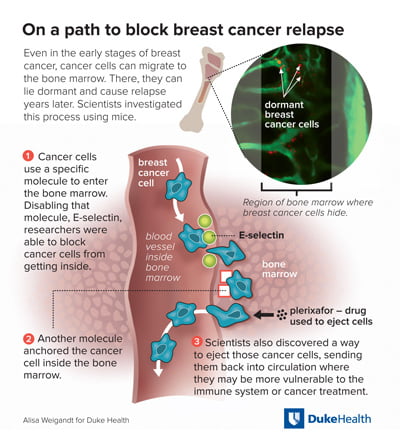Scientists prevent breast cancer cells entering bone marrow
Posted: 25 May 2016 | Victoria White, Digital Content Producer | No comments yet
Scientists have identified a molecular key that breast cancer cells use to invade bone marrow in mice, where they may be protected from therapies…


CREDIT: Alisa Weigandt for Duke Health
Scientists have identified a molecular key that breast cancer cells use to invade bone marrow in mice, where they may be protected from chemotherapy or hormonal therapies.
The scientists from the Duke Cancer Institute have found ways to outmanoeuvre this tactic by not only preventing breast cancer cells from entering the bone marrow, but also by flushing cancer cells out into the blood stream where they could be targeted for destruction. The findings provide insight into breast cancers ability to return after seemingly being vanquished. The researchers hope the findings could eventually lead to new therapies for treating breast cancer.
“Clinical studies have found that breast cancer can be caught early and treated, and patients can have no signs of disease,” said Dorothy A. Sipkins, M.D., Ph.D., associate professor in the division of haematological malignancies and cellular therapy at Duke. “And then five, 10 or even 15 years later, a patient can relapse. Most often, the site of the metastasized cancer is in the bone.”
The researchers have described how cells from breast cancers that are hormone receptor-positive roam through the blood and tissues of mice. They are hunting for specific blood vessels in bone marrow that contain the molecule E-selectin. With molecules on their surface that bind to E-selectin, the cancer cells enter the spongy tissue inside bones, often lying dormant for years.
GMI-1271 successfully prevented breast cancer cells entering bone marrow
In human patients, dormant cancer cells can resurge later and create metastatic cancer relapse, for which there is no cure, said Sipkins. Biopsies of bone marrow in human breast cancer patients have shown that even at very early stages of the cancer, roaming cancer cells, or micrometastases, are making their way out of the breast and into the bone marrow, Sipkins said.
She said: “In the mouse, our findings could offer new strategies to intervene at the molecular level before dormant cells can take hold and cause relapse.”
One strategy is finding a way to inhibit E-selectin, which could limit the cancer’s ability to travel into the bone and resurge as metastatic cancer. The scientists used an E-selectin inhibitor called GMI-1271, which is currently in human clinical trials. They found the compound successfully prevented the breast cancer cells from entering the bone marrow in mice.
Plerixafor forced dormant breast cancer cells out of bone tissue
Because microscopic metastases can spread to the bone marrow before patients are even diagnosed with breast cancer, the researchers also tested a strategy that appears to kick dormant breast cancer cells out of their safe house in the bone marrow and back into circulation. They gave the mice plerixafor, an agent used in human bone marrow donors to push stem cells into the bloodstream for harvesting.
The drug was able to force dormant breast cancer cells out of the bone tissue into the bloodstream. The researchers hypothesise that flushing these dormant cancer cells back into the bloodstream might give the immune system, chemotherapy or hormonal therapy another opportunity at killing them off, Sipkins said. She and colleagues hope to investigate that approach further.
Related conditions
Breast cancer
Related organisations
Duke University



